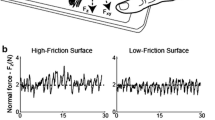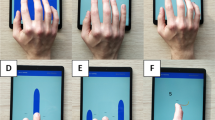Abstract
Touch screens are becoming ubiquitous technology, allowing for enhanced speed and convenience of user interfaces. To date, the majority of touch screen usability studies have focused on timing and accuracy of young, healthy individuals. This information alone may not be sufficient to improve accessibility and usability of touch screens. Kinetic data (e.g. force, impulse, and direction) may provide valuable information regarding human performance during touch screen use. Since kinetic information cannot be measured with a touch screen alone, touch screen-force plate instrumentation, software, and methodology were developed. Individuals with motor control disabilities (Cerebral Palsy and Multiple Sclerosis), as well as gender- and age-matched non-disabled participants, completed a pilot reciprocal tapping task to evaluate the validity of this new instrumentation to quantify touch characteristics. Results indicate that the instrumentation was able to successfully evaluate performance and kinetic characteristics. The kinetic information measured by the new instrumentation provides important insight into touch characteristics which may lead to improved usability and accessibility of touch screens.




Similar content being viewed by others
References
Armstrong, T.J., et al.: Investigation of applied forces in alphanumeric keyboard work. Am. Ind. Hyg. Assoc. J. 55(1), 30–35 (1994)
Dennerlein, J.T., Mote, C.D., Rempel, D.M.: Control strategies for finger movement during touch typing—the role of the extrinsic muscles during a keystroke. Exp. Brain Res. 121(1), 1–6 (1998)
Gerard, M.J., et al.: The effects of keyswitch stiffness on typing force, finger electromyography, and subjective discomfort. Am. Ind. Hyg. Assoc. J. 60(6), 762–769 (1999)
Radwin, R.G., Ruffalo, B.A.: Computer key switch force-displacement characteristics and short-term effects on localized fatigue. Ergonomics 42(1), 160–170 (1999)
van Roon, D., Steenbergen, B., Hulstijn, W.: Reciprocal tapping in spastic hemiparesis. Clin. Rehabil. 14(6), 592–600 (2000)
Steenbergen, B., et al.: The timing of prehensile movements in subjects with cerebral palsy. Dev. Med. Child Neurol. 40(2), 108–114 (1998)
Piek, J.P., Skinner, R.A.: Timing and force control during a sequential tapping task in children with and without motor coordination problems. J. Int. Neuropsychol. Soc. 5(4), 320–329 (1999)
Schedlbauer, M.J.: Effects of key size and spacing on the completion time and accuracy of input tasks on soft keypads using trackball and touch input. In: Human Factors and Ergonomics Society 51st annual meeting, 2007. Baltimore, MD: Human Factors and Ergonomics Society, Inc., Santa Monica, CA, USA
Scott, B., Conzola, V.: Designing touch screen numeric keypads: effects of finger size, key size, and key spacing, 1997. Albuquerque, NM, USA: Human Factors and Ergonomics Society, Inc., Santa Monica, CA, USA
Potter, R.L., Weldon, L.J., Shneiderman, B.: Improving the accuracy of touch screens, an experimental evaluation of three strategies. In: ACM CHI conference on human factors in computing systems, 1988. Washington, D.C.: ACM
Sears, A., Revis, D., Swatski, J., Crittenden, R., Shneiderman, B.: Investigating touchscreen typing: the effect of keyboard size on typing speed. Behav. Inf. Technol. 2(1), 17–22 (1993)
Colle, H.A., Hiszem, K.J.: Standing at a kiosk: effects of key size and spacing on touch screen numeric keypad performance and user preference. Ergonomics 47(13), 1406–1423 (2004)
Jin, Z.X., Plocher, T., Kiff, L.: Touch screen user interfaces for older adults: button size and spacing. In: Stephanidis, C. (ed.) Universal Acess in Human Computer Interaction. Coping with Diversity. Springer, Berlin, Heidelberg (2007)
Lee, S., Zhai, S.: The performance of touch screen soft buttons. In: ACM CHI conference on human factors in computing systems, 2009. Boston, MA: ACM
Sears, A.: Improving touchscreen keyboards: design issues and a comparison with other devices. Interact. Comput. 3(3), 253–269 (1991)
Breinholt, G., Krueger, H.: Evaluation of key shapes on a touchscreen simulation of a specialised keypad. Appl. Ergonomics 27(6), 375–379 (1996)
Hall, A., et al.: Factors affecting performance using touch-entry systems: tactual recognition fields and system accuracy. J. Appl. Psychol. 73(4), 711–720 (1988)
Mascaro, S.A., Asada, H.H.: Measurement of finger posture and three-axis fingertip touch force using fingernail sensors. IEEE Trans. Robot. Autom. 20, 26–35 (2004)
Jiang, L., Ruutianinen, J., Cutkosky, M.R., Raisamo, R.: Improving finger force control with vibrational haptic feedback for multiple sclerosis. In: The international association of science and technology for development (IASTED), 2008. Baltimore, MD
Collins, S.H., et al.: A simple method for calibrating force plates and force treadmills using an instrumented pole. Gait Posture 29(1), 59–64 (2009)
Acknowledgments
The contents of this paper were developed under grant H133E030012 from the National Institute on Disability and Rehabilitation Research (NIDRR), U.S. Department of Education. However, these contents do not necessarily represent the policy of the Department of Education, and you should not assume endorsement by the federal government.
Author information
Authors and Affiliations
Corresponding author
Rights and permissions
About this article
Cite this article
Irwin, C.B., Yen, T.Y., Meyer, R.H. et al. Use of force plate instrumentation to assess kinetic variables during touch screen use. Univ Access Inf Soc 10, 453–460 (2011). https://doi.org/10.1007/s10209-011-0218-z
Published:
Issue Date:
DOI: https://doi.org/10.1007/s10209-011-0218-z




